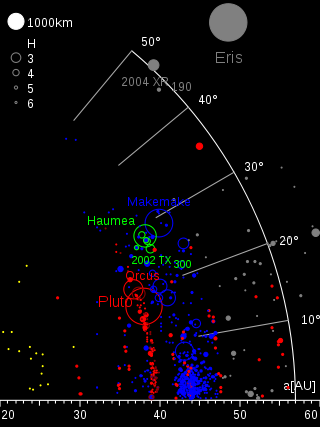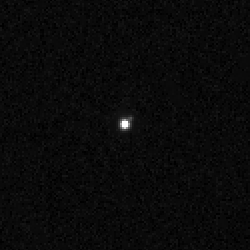Related Research Articles

Dejanira is a main belt asteroid that was discovered by Alphonse Borrelly on 1 December 1875, and named after the warlike princess Deianira in Greek mythology. The Dejanira family of asteroids is named after it.

(208996) 2003 AZ84 is a trans-Neptunian object with a possible moon located in the outer regions of the Solar System. It is approximately 940 kilometers across its longest axis, as it has an elongated shape. It belongs to the plutinos – a group of minor planets named after its largest member Pluto – as it orbits in a 2:3 resonance with Neptune in the Kuiper belt. It is the third-largest known plutino, after Pluto and Orcus. It was discovered on 13 January 2003, by American astronomers Chad Trujillo and Michael Brown during the NEAT survey using the Samuel Oschin telescope at Palomar Observatory.
(24835) 1995 SM55, provisional designation 1995 SM55, is a trans-Neptunian object and member of the Haumea family that resides in the Kuiper belt, located in the outermost region of the Solar System. It was discovered on 19 September 1995, by American astronomer Nichole Danzl of the Spacewatch program at Kitt Peak National Observatory near Tucson, Arizona, in the United States. It measures approximately 200 kilometers in diameter and was the second-brightest known object in the Kuiper belt, after Pluto, until 1996 TO66 was discovered.

(145453) 2005 RR43, also written as (145453) 2005 RR43, is a trans-Neptunian object (TNO) estimated to be about 250 km in diameter. It was discovered on 9 September 2005 by Andrew Becker, Andrew Puckett and Jeremy Kubica at Apache Point Observatory in Sunspot, New Mexico.

(86047) 1999 OY3, also written as (86047) 1999 OY3, is a trans-Neptunian object that resides in the Kuiper belt beyond Pluto. It was discovered on July 18, 1999, at the Mauna Kea Observatory, Hawaii, USA.

(202421) 2005 UQ513, also written as 2005 UQ513, is a cubewano with an absolute magnitude of 3.97. Its spectrum has a weak signature of absorption by water ice. Like Quaoar, it has a very red spectrum, which indicates that its surface probably contains many complex, processed organic molecules. Its light curve shows variations of Δm=0.3 mag, but no period has been determined.

The Haumea or Haumean family is the only identified trans-Neptunian collisional family; that is, the only group of trans-Neptunian objects (TNOs) with similar orbital parameters and spectra that suggest they originated in the disruptive impact of a progenitor body. Calculations indicate that it is probably the only trans-Neptunian collisional family. Members are known as Haumeids.

(528381) 2008 ST291, provisional designation 2008 ST291, is a 1:6 resonant trans-Neptunian object located in the outermost region of the Solar System that takes almost a thousand years to complete an orbit around the Sun. It was discovered on 24 September 2008 by American astronomers Megan Schwamb, Michael Brown and David Rabinowitz at the Palomar Observatory in California, with no known earlier precovery images.

(386723) 2009 YE7, provisional designation 2009 YE7, is a trans-Neptunian object (TNO) discovered by David Rabinowitz on December 17, 2009, at the La Silla Observatory in Chile.
2010 KZ39 is a trans-Neptunian object orbiting the Sun as a detached object in the outer reaches of the Solar System. The object was first observed on 21 May 2010 by astronomers Andrzej Udalski, Scott Sheppard, M. Szymanski and Chad Trujillo at the Las Campañas Observatory in Chile.
(523639) 2010 RE64, provisional designation 2010 RE64, is a trans-Neptunian object in the scattered disc located in the outermost region of the Solar System, approximately 570 kilometers (350 miles) in diameter. It was discovered on 11 July 2010 by the Pan-STARRS-1 survey at the Haleakala Observatory, Hawaii, in the United States.
(469306) 1999 CD158, provisional designation: 1999 CD158, is a trans-Neptunian object from the circumstellar disc of the Kuiper belt, located in the outermost region of the Solar System. The relatively bright hot classical Kuiper belt object measures approximately 310 kilometers (190 miles) in diameter. It was discovered on 10 February 1999, by American astronomers Jane Luu, David Jewitt and Chad Trujillo at Mauna Kea Observatories on the Big Island of Hawaii, United States.
(524435) 2002 CY248, provisional designation 2002 CY248, is a trans-Neptunian object and weak dwarf-planet candidate from the classical Kuiper belt in the outermost region of the Solar System, approximately 400–450 kilometers (250–280 mi) in diameter. It was first observed on 6 February 2002, by American astronomer Marc Buie at the Kitt Peak National Observatory in Arizona, United States.
(523643) 2010 TY53, provisional designation 2010 TY53 is a trans-Neptunian object and possible centaur located in the outermost region of the Solar System. With an absolute magnitude of 5.7, it approximately measures 325 kilometers (200 miles) in diameter. It was discovered on 4 August 2010 by the Pan-STARRS-1 survey at the Haleakala Observatory, Hawaii, in the United States. According to American astronomer Michael Brown, it is "possibly" a dwarf planet.
(471288) 2011 GM27 is a trans-Neptunian object (TNO) in the Kuiper belt, classified as a hot classical Kuiper belt object. It was discovered on 2 April 2011, at ESO's La Silla Observatory in Chile. With an absolute magnitude of 5.32, a geometric albedo of between 0.06 to 0.09 (a typical value) would mean it has a diameter of about 450 kilometers (280 mi).

(532037) 2013 FY27 is a trans-Neptunian object and binary system that belongs to the scattered disc (like Eris). Its discovery was announced on 31 March 2014. It has an absolute magnitude (H) of 3.2. 2013 FY27 is a binary object, with two components approximately 740 kilometres (460 mi) and 190 kilometres (120 mi) in diameter. It is the ninth-intrinsically-brightest known trans-Neptunian object, and is approximately tied with 2002 AW197 and 2002 MS4 (to within measurement uncertainties) as the largest unnamed object in the Solar System.
(523645) 2010 VK201, provisional designation 2010 VK201, is a trans-Neptunian object and member of the classical Kuiper belt, approximately 500 kilometers (310 miles) in diameter. It was discovered on 1 November 2010, by the Pan-STARRS 1 survey at Haleakala Observatory, Hawaii, United States. It has a rotation period of 7.6 hours. It was numbered in September 2018 and remains unnamed.
(78799) 2002 XW93, provisional designation 2002 XW93, is a trans-Neptunian object and centaur from the outer Solar System, approximately 500–600 kilometers (300–400 mi) in diameter. It was discovered on 10 December 2002, by astronomers at the Palomar Observatory in California.
(523759) 2014 WK509, provisional designation 2014 WK509 is a trans-Neptunian object in the scattered disc, located in the outermost regions of the Solar System. It was discovered on 14 September 2010, by Pan-STARRS at Haleakala Observatory on the island of Maui, Hawaii, in the United States. The object's diameter has been estimated to measure approximately 600 kilometers.
(315530) 2008 AP129 is a trans-Neptunian object and possibly a cubewano from the outermost regions of the Solar System, approximately 480 kilometers in diameter. It was discovered on 11 January 2008, by American Michael E. Brown and Megan Schwamb at Palomar Observatory in California.
References
- ↑ "2010 FW62". Minor Planet Center . Retrieved 31 August 2012.
- 1 2 3 "JPL Small-Body Database Browser: (2011 FW62)" (2011-05-26 last obs). Retrieved 12 April 2016.
- ↑ Michael E. Brown. "How many dwarf planets are there in the outer solar system? (updates daily)". California Institute of Technology. Archived from the original on 18 October 2011. Retrieved 31 August 2012.
- ↑ Proudfoot, Benjamin; Ragozzine, Darin (May 2019). "Modeling the Formation of the Family of the Dwarf Planet Haumea". The Astronomical Journal. 157 (6): 230. arXiv: 1904.00038 . Bibcode:2019AJ....157..230P. doi: 10.3847/1538-3881/ab19c4 . S2CID 90262136.